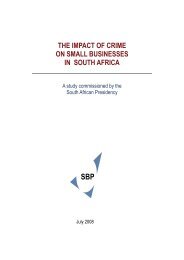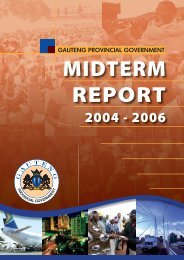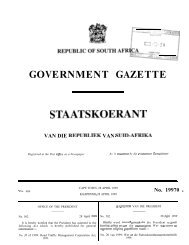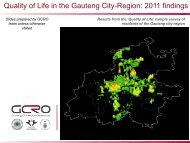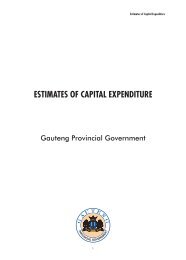the gauteng spatial development framework - Gauteng Online
the gauteng spatial development framework - Gauteng Online
the gauteng spatial development framework - Gauteng Online
Create successful ePaper yourself
Turn your PDF publications into a flip-book with our unique Google optimized e-Paper software.
HARMONISING HOUSING PROVISION AND SUBSIDIES WITHTHE WIDER URBAN SYSTEM WITH PARTICULAR REFERENCETO THE BREAKING NEW GROUND (BNG) POLICYIt is clear that <strong>the</strong> provision of state and provincially subsidised housing for first-time homeowners who qualify for <strong>the</strong> once-off housing subsidy is accountable for a substantial amountof pressure to extend beyond <strong>the</strong> existing limits of <strong>the</strong> urban extent. One assumes that (a)<strong>the</strong> relatively lower cost of land in <strong>the</strong>se peripheral areas makes <strong>the</strong> land component ofhousing delivery more affordable; (b) <strong>the</strong> assembly of extensive tracts of land at scale ismore easily achieved in <strong>the</strong>se peripheral zones; and (c) <strong>the</strong> land in <strong>the</strong>se areas is politicallyless contested than areas more embedded in <strong>the</strong> urban system where <strong>the</strong> not- in-my-backyard(NIMBY) syndrome is more prevalent.The issue, of course, is not new and has been debated vociferously since <strong>the</strong> transition.Much of <strong>the</strong> more recent Breaking New Ground (BNG) policy, in fact, seeks to redress this.Never<strong>the</strong>less, for as long as (a) housing provision continues to be seen as an element in itsown right only, and is considered in isolation of <strong>the</strong> urban system and its <strong>development</strong>alconsiderations as a whole; and (b) a 'one-size-fits-all' subsidy system persists, taking nocognisance of subsidy and policy harmonisation with o<strong>the</strong>r aspects of <strong>the</strong> urban system,such as transportation, for example, <strong>the</strong> issues and problems associated with marginalisedcommunities as driven by housing policy will remain intractable.The net result, however, whe<strong>the</strong>r intended or not, is <strong>spatial</strong>ly not acceptable. Equally, <strong>the</strong>socio-economic consequences of this urban marginalisation, and <strong>the</strong> very real additionalcosts incurred by households in <strong>the</strong>se areas, cannot be allowed to continue. Disproportionatelyhigher amounts of meagre incomes are spent on commuting relative to those elsewherein <strong>the</strong> urban system, and <strong>the</strong> costs of goods and services in <strong>the</strong>se peripheral zones are, onbalance, higher. Social facilities, infrastructural services and amenities are also of lesserprovision and calibre and, at best, only <strong>the</strong> limited growth of a local economy is possibleunder <strong>the</strong>se conditions of marginalisation.Not only does <strong>the</strong> urban structure fail, on <strong>the</strong>se terms, to assimilate <strong>the</strong> marginalised poorinto <strong>the</strong> opportunities offered by <strong>the</strong> urban system, but <strong>the</strong> urban system itself also remainsunsustainable. Notwithstanding <strong>the</strong> high transport costs, for example, borne by households,<strong>the</strong> transportation subsidies incurred are also very high. Infrastructural services, socialfacilities and amenities are based on patterns of sprawled, low intensity urban expansionthat cannot be provided and maintained on a cost-effective basis. The mono-use patternsof urban <strong>development</strong>, notably extensive low-income housing, mean that no critical massand diversification of utility is possible, which similarly reduces <strong>the</strong> cost-effectiveness ofservice delivery.To be fair, one cannot simply ignore <strong>the</strong> very real problems associated with <strong>the</strong> NIMBYsyndrome, <strong>the</strong> difficulties of finding significant amounts of public land, and <strong>the</strong> cost of landin <strong>the</strong> better performing areas of <strong>the</strong> urban system. Yet it is precisely <strong>the</strong>se areas wherebest advantage of <strong>the</strong> integration of low income housing into <strong>the</strong> urban system can andmust be gained. Again, however, <strong>the</strong> response to <strong>the</strong>se difficulties cannot be a capitulationthat sees <strong>the</strong> very underpinnings of a sustainable urban system and <strong>the</strong> well-being of allthose in <strong>the</strong> city, particularly those who are <strong>the</strong> recipients of subsidised housing, beingcompromised. The leadership required to shape and direct a sustainable urban structure,and to accommodate <strong>the</strong> undoubted growth that is inevitably being targeted at <strong>the</strong> GCRin a positive way is a responsibility of Province that cannot be abrogated.The transformation of <strong>the</strong> urban structure of <strong>the</strong> GCR needs to directly challenge <strong>the</strong> basison which housing subsidies and delivery now takes place. Differentials in housing subsidiesmust be recognised by virtue of a favourable setting within <strong>the</strong> urban system from aneconomic opportunity point of view; <strong>the</strong> extent to which existing public transport systemscan be used or easily augmented; existing services can be used or easily augmented; existingsocial facilities can be used or easily augmented; and in which higher-density forms ofANNEXURE B: POLICY POSITION PAPERSGAUTENG SPATIAL DEVELOPMENT FRAMEWORK 2011GAUTENG GROWTH AND DEVELOPMENT AGENCY138



